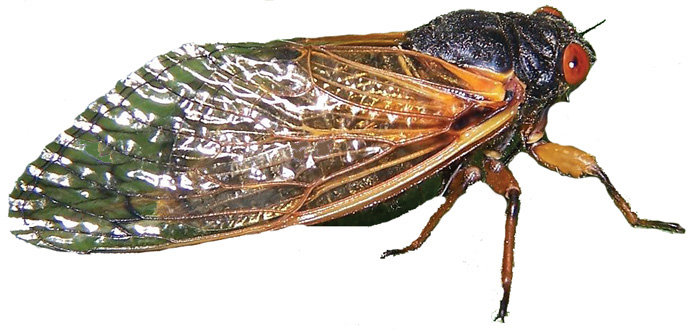The buzz you will be hearing shortly doesn’t have anything to do with current events or even politicians. The buzz you will hear will be the return of the 17-year cicadas, which are set to reveal themselves any time now. Some call cicadas locusts, but they are not locusts. Locust is a form of a grasshopper. They are often confused, as they both make a lot of racket.
In Ohio, there are four species of these little creatures, three of which are cyclical, according to officials at the Ohio Department of Natural Resources. There are also those we hear every year, called the annual dog-day cicadas. They are larger than the others, with a green and black body, transparent wings with green veining, and black eyes. Those cicadas, which many equate to the sounds of summertime, appear from June through September, producing that unmistakable cacophony. The 17-year cicadas are only about 1 to 1.5 inches long. They are black with orange legs, transparent wings that have a red/orange veining, with red eyes.
Of course, the 17-year cicadas won’t really arrive. They are already here, patiently living on roots below ground, since 1999. During that time, they are wingless cicada nymphs. According to the ODNR, “After mating, the female cicada cuts into the twigs of trees to create a scar in which to deposits her eggs. She will lay approximately 400-600 eggs. After six to eight weeks, the eggs hatch and the wingless cicada nymphs drop to the ground and tunnel through the soil where they feed on the juices of the tree roots. After 17 years of feeding, the cicadas emerge and climb an upright surface where it anchors itself and completes its transformation into an adult. A white adult with wings emerges from its old nymphal skin. The skin soon darkens and hardens. The cicadas then mate and the cycle repeats itself.” This 17-year cycle makes them one of the longest living insects in the world.
When the soil temperature reaches between 65 and 70 degrees, the cicadas will emerge. North Royalton, overall, has not been too affected, said Bob Witsaman, owner of Royal Victorian Gardens. This is because much of the area in North Royalton was farm land, which was disturbed by tilling, upending the cicadas. “You’ll find them more in pockets of older forested areas,” said Witsaman.
When they emerge, the cicadas will look for trees and large bushes for the nymphs to feed on, sucking out the fluid from the trees, bushes and their roots, in order to develop. They like soil that is not too wet. It takes about two weeks for them to emerge. The cicada live up to a month, in which time they emerge, mate, lay eggs and then die.
The good news is that cicadas don’t bite and they really do little damage. There is no effective way to get rid of them. “There’s not much to be done,” said Bob Witsaman, owner of Royal Victorian Gardens. He said that the cicadas are known as ‘nature’s tree trimmers’. “The damage to the outer tip of new growth takes place when the female makes a slip in the tender growth and lays eggs in the branches. As the egg matures and the winds blow the branches then fall down and the eggs hatch and go into the ground.”
Although cicadas are popular cooked in parts of South America and Africa, don’t look for a Table Talk featuring cicadas. It just isn’t a popular dish – yet 🙂
By GLORIA PLEVA KACIK
Contributing Writer






